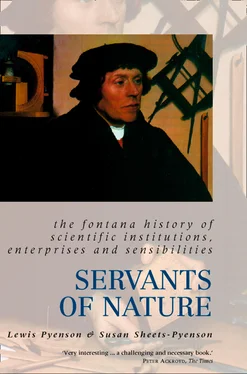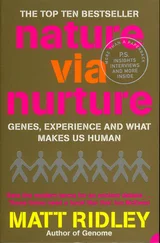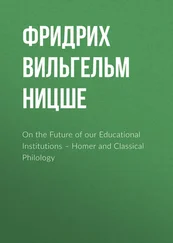Along with the end of the university institute came the rise of the university department . By 1900 professors and lecturers sometimes organized sequences of courses, assigning responsiblity for all the parts of a domain, but the spectacular fragmentation of knowledge led to a hierarchical structure for managing it only in the United States. There, the arrangement extended to a military command structure, with a department chair, professors, associate professors, assistant professors, and a host of supporting staff. The departmental innovation coincided with the rise of the department store and the departmentally structured industrial firm. The inspiration is found in the administrative units of the federal government. With the model of academic departments in science, American universities distanced themselves from the European tradition where a professor taught what he liked. Science instruction became highly organized and goal-oriented. In the nineteenth century, European academics were traditionally able to take advantage of fast-breaking developments in neighbouring disciplines; in the twentieth century, innovative American academics spent much time and energy breaking out of disciplinary confinement.
Both geographical decentralization and interdisciplinary innovation have become watchwords in academic science. Electronic information-processing to some extent obviates the necessity for a scientist or scholar to reside at an ancient college of learning. Universities everywhere have adapted to new socioeconomic conditions by expanding curricula. They have always responded in this way, although never as quickly as their critics would like.
Measured and deliberate innovation is one of academia’s heavy burdens. It is also a great strength. Emerging fields of knowledge become new scientific disciplines only after they have found a secure place in universities. We look to universities for an authoritative word about the latest innovations. New scientific ideas emerge in a variety of settings, but they become the common heritage of humanity only when processed by an institution for advanced instruction like the modern university.
3 Sharing: Early Scientific Societies
Above the deafening cacophony of a dozen screaming four-year-olds, a daycare teacher admonishes, ‘Now share!’ The concept of sharing a toy – of sacrificing individual possession for a communal experience, of deferring pleasure until others have taken a turn at gratification – is altogether foreign to the toddler, whose universe heretofore has been entirely self-centred and unabashedly selfish. It is seen as an important measure of maturity when the child is able to transcend the universe of ‘me and mine’, and to begin to entertain the idea of a greater social imperative.
The development of science seems to recapitulate the odyssey of every individual as he matures from infantile egotism to participation in the universe of social give-and-take. In the ancient and medieval worlds, learning about the natural world proceeded by fits and starts. People recorded intriguing theories and thoughts, constructed ingenious mechanisms and monuments, and even established schools. There existed, however, no special notion of a common mission to uncover new truths about nature, no clear idea that a division of labour could prove especially conducive to the rapid accumulation of knowledge. Earlier thinkers tended to guard and keep secret what they knew, fearing that good ideas might be stolen by a rival.
With the Scientific Revolution of the mid seventeenth century, the cultivation of natural knowledge ceased to be solitary and introspective; it became shared and communal. By working together , according to this new outlook, philosophers could accomplish more than they could by working separately; the cumulation of individual efforts by sharing would result in more gains to science than the summing of its isolated parts. Furthermore, what contemporaries labelled the ‘new science’ – signified by a corporate or composite effort – also aimed to replace words with deeds, the library with the laboratory, and systems with facts. This emphasis on activism, experiment, and experience stimulated the establishment of scientific societies, special associations where individuals could congregate and cooperate in advancing the new science. 1 In this chapter we examine the anatomy of the new societies.
These institutions for sharing became the dominating and distinguishing feature of science during the second half of the seventeenth century. Scientific societies were an essential component, not a mere by-product, of the Scientific Revolution. They became a vital instrument for formulating and transmitting scientific norms and values. They transcended the pedagogical tradition associated with universities and established a new routine, inspired by everyday circumstances. Scientific societies held meetings at regular intervals; they elected officers and set up committees. Such daily activity led to the establishment of ‘a seasonal calendar of ritual: the first formal meeting of the year, periods of election, ordinary meetings, breaks for religious and state holidays, public meetings, vacation’ and so forth. 2 Scientific societies may have exalted the tedious and the dull, but they enshrined a secular calendar for these mundane affairs – an essential figure of modernity. In other words, time was organized without the traditional appeal to sacred celebrations or agricultural cycles.
What led natural philosophers to embrace a new ideology associated with sharing ? Certainly they did not think that invention would cease to be the fruit of one mind and would become a collective procedure. They were, after all, proud of their own discoveries. Rather, they saw advantages to associating with a group of like-minded people. The form of their association departed from medieval guilds. Associations for promoting the new science ignored matters of faith and livelihood. Nor did scientific associations seek to train apprentices. They were an avocational service club – the seventeenth-century equivalent of the Odd Fellows or Rotarians.
The learned society or academy of the seventeenth century incited and rewarded independent work. It also provided an avenue for communicating the results of scientific investigations, at first by means of the private correspondence of a secretary, and later through formal minutes and journals. Scientific societies housed books in their libraries, displayed specimens in their museums, and collected instruments in their cabinets, all these services assisting the investigations of individual members. Groups were naturally better able to purchase the costly tools required by the new science, whether telescopes, microscopes, or burning-mirrors. In this way, scientific societies made the materiel for conducting science accessible in a convenient and relatively inexpensive form. By the end of the seventeenth century, any man of scientific reputation and accomplishment belonged to a learned society or academy.
Nascent scientific organizations fulfilled less obvious functions, as well. Just to be associated with these enterprises conferred prestige on a member. This has been true virtually from the beginning, and ‘FRS’ (Fellow of the Royal Society of London) or ‘membre de l’Institut’ (member of one of the national academies of France) is today a coveted designation. In addition to this honorific function, periodic meetings of societies provided a forum for individuals to meet and discuss their work. Universities had no real place for the exchange of ideas among equals (there were neither faculty clubs nor professorial offices), but in the halls of the academy, controversies could be aired, alliances forged, and criticisms vetted.
Whence the notion for these associations? Some of them found inspiration in an invocation of Platonic free assembly and corporate activity, beyond political control. Others looked back to the Renaissance, when learned men came together under the influence of a particular patron or court. Yet, as we shall see, the Royal Society of London represented a novel departure: For the first time, individuals united together in a public body dedicated to the corporate prosecution of scientific research.
Читать дальше












